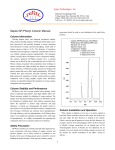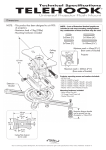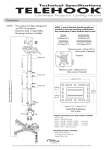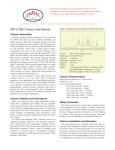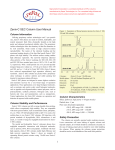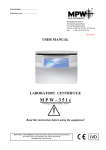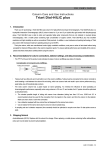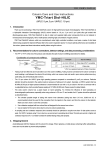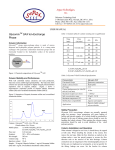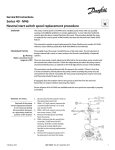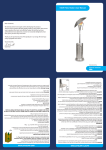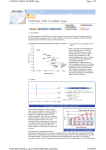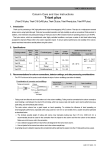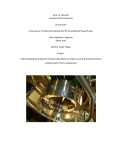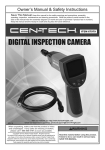Download User Manual - Sepax Technologies, Inc.
Transcript
Sepax Technologies, Inc. Delaware Technology Park 5 Innovation Way, Newark, DE 19711, USA Phone: (302) 366-1101; Fax: (302) 366-1151 Toll Free: 1-877-SEPAX-US; www.sepax-tech.com Sepax HP-Silica Column Manual Column Information 1 0.7 2 Utilizing highest purity and enhanced mechanical stability silica, HP-Silica phases have been specially designed by activating the surface to ensure extremely well controlled silica surface structure that results in very reliable column-to-column reproducibility. The activated silica without any organic layer bonded to its surface allows HP-Silica to have exceptional stability. The uniform, spherical HP-Silica particles have a nominal surface area of 300, 200 and 100 m2/g with a controlled pore size of 120Å, 200Å and 300 Å, respectively. HP-Silica columns are packed with a proprietary slurry technique to achieve uniform and stable packing bed density for maximum column efficiency. HP-Silica phases are specially designed to enable high selectivity for polar and hydrophilic compounds. The intrinsic polar silanol phase of HP-Silica offers much less retention for most non-polar compounds. HP-Silica columns can perform excellent separations in organic solvents or a mixture of water and organic solvent, such as methanol and acetonitrile. Typical applications for HP-Silica are the separations of both polar and basic organic compounds, such as vitamins, steroids, as well as pharmaceuticals. HP-Silica columns are widely used for LC/MS method development for analysis of pharmaceuticals, especially nitrogen contained compounds. 0.6 AU 0.5 0.4 3 0.3 0.2 0.1 0.0 0 2 4 6 8 10 12 14 16 18 20 22 24 Min Column: HP-Silica (5µm, 120Å, 4.6x250mm) Mobile phase: 14.7% EtOH/0.3% H2O/85% Isooctane Flow rate: 1.0 mL/min Detector (UV): 254 nm Injection volume: 3.0 µL Temperature: Ambient (23 oC) Sample: 1. Toluene 2. Benzanilide 3. p-Nitroaniline Column Stability and Performance Safety Precaution HP-Silica phase does not have any bonded organic layer, which allows exceptional high stability. Such high stability allows HPsilica suitable for validation of various analytes. Its activated surface of HP-Silica offers polar groups and charged Si-O- groups for hydrophilic and electrostatic interactions with a variety of compounds, achieving high selectivity and high efficiency separations. Without organic layer bonded to its surface, HPSilica phase avoids degradation of the stationary phase that is a typical problem associated with all other stationary phases. Separations could be in the non-polar solvents, such as hexane, or polar solvents, such as a mixture of acetonitrile and water. A typical test chromatogram for quality control is shown here for a HP-Silica 4.6x250mm column. HP-Silica columns are normally operated under high pressure. Loose connections will cause leaking of organic solvents and injected samples, all of which should be considered as the hazards. In the case of leaking, proper gloves should be worn for handling the leaked columns. When open the columns, proper protections should be used to avoid inhalation of the small silica particles. Column Installation and Operation When the column is shipped or not in use, it is always capped at both ends. When install the column to the system, first remove the end caps. Make the flow direction as marked on the column. Unless a user has special purpose to reverse the flow direction, for example, removal of the inlet pluggage, follow the flow direction as labeled. Column connections are an integral part of the 1 Temperature The maximum operating temperature is 60oC. Continuous use of the column at higher temperature (>75oC) can damage the column, especially under high pH (>8.5). Storage When not in use for extended time, do not allow water or aqueous buffer to remain in the column. Remove any aqueous buffers by washing with at least 20-30 column volumes of 50% methanol or acetonitrile aqueous solution, followed by 20-30 column volumes of the pure solvent such as acetonitrile. Each column is shipped with two removable end plugs. To prevent the drying of the column bed, seal both ends of the column with the end plugs provided. chromatographic process. If ferrules are over tightened, not set properly, or are not specific for the fitting, leakage can occur. Set the ferrules for column installation to the HPLC system as follows: (a) Place the male nut and ferrule, in order, onto a 1/16" o.d. piece of tubing. Be certain that the wider end of the ferrule is against the nut. (b) Press tubing firmly into the column end fitting. Slide the nut and ferrule forward, engage the threads, and fingertighten the nut. (c) While continuing to press the tube firmly into the endfitting, use a 1/4" wrench to further if necessary. (d) Repeat this coupling procedure for the other end of the column. New columns are shipped in the mobile phase used for QC test. During stocking and shipping, the silica packing could be dried out. It is recommended that 10-20 column volumes of pure organic solvents, such as methanol, acetonitrile be purged to activate the column. Flush the column with your mobile phase with gradual increasing the flow rate from 0.1 mL/min to your operation condition, until the baseline is stable. If the column backpressure and baseline fluctuate, this might be due to the air bubbles trapped inside the column. Flush the column with higher flow rate for 2-5 minutes, for example 2 mL/min for a 4.6x150 mm column. Sepax HP-Silica Products ID x Length 2.1x150mm 2.1x100mm 2.1x50mm 2.1x30mm Samples and Mobile Phases To avoid clogging the column, all samples and solvents including buffers should be filtered through 0.45 µm or 0.2 µm filters before use. HP-silica phase has wide compatibility with wide range of solvents, including non-polar, such as isopropanol/hexane, polar organic solvents, such as water, a mixture of organic and water (e.g. methanol or acetonitrile and water), and aqueous buffer, such phosphate or borate. Always degas the mobile phase. A simple way for degassing is to sonicate it for 5 minutes under water pumped vacuum. 2 Pore size P/N 120 Å 120 Å 120 Å 3 µm 120 Å 117003-2115 117003-2110 117003-2105 117003-2103 4.6x250mm 4.6x150mm 4.6x100mm 4.6x50mm 3 µm 3 µm 3 µm 3 µm 120 Å 120 Å 120 Å 120 Å 117003-4625 117003-4615 117003-4610 117003-4605 2.1x250mm 2.1x150mm 2.1x100mm 2.1x50mm 2.1x30mm 5 µm 5 µm 5 µm 5 µm 5 µm 120 Å 120 Å 120 Å 120 Å 120 Å 117005-2125 117005-2115 117005-2110 117005-2105 117005-2103 4.6x250mm 4.6x150mm 4.6x100mm 4.6x50mm 5 µm 5 µm 5 µm 5 µm 120 Å 120 Å 120 Å 120 Å 117005-4625 117005-4615 117005-4610 117005-4605 7.8x250mm 10.0x250mm 21.2x250mm 21.2x150mm 21.2x50mm 5 µm 5 µm 5 µm 5 µm 5 µm 120 Å 120 Å 120 Å 120 Å 120 Å 117005-7825 117005-10025 117005-21225 117005-21215 117005-21205 7.8x250mm 10.0x250mm 21.2x250mm 21.2x150mm 21.2x50mm 7 µm 7 µm 7 µm 7 µm 7 µm 120 Å 120 Å 120 Å 120 Å 120 Å Column Care PH Avoid using HP-Silica columns below pH 2 or above 9. Higher pH will dissolve silica, creating defects of the stationary phase that causes separation efficiency loss and retention time change. The optimum performance and operation for longest lifetime are at pH 2 - 8.5. Pressure Even though the column can operate at pressure up to 5,000 psi, the normal operation is usually under 3,000 psi. Continuous use at high pressure may eventually damage the column as well as the pump. Since the pressure is generated by the flow rate. The maximum flow rate is limited by the backpressure. It is expected that the backpressure might gradually increase with its service. A sudden increase in backpressure suggests that the column inlet frit might be plugged. In this case it is recommended that the column be flushed with reverse flow in an appropriate solvent. Particle size 3 µm 3 µm 3 µm 117007-7825 117007-10025 117007-21225 117007-21215 117007-21205


